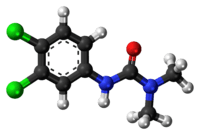DCMU
 | |
 | |
| Names | |
|---|---|
| Other names
3-(3,4-Dichlorophenyl)-1,1-dimethylurea, Karmex, Diuron, Direx | |
| Identifiers | |
| 330-54-1 | |
| 3D model (Jmol) | Interactive image |
| ChEBI | CHEBI:116509 |
| ChEMBL | ChEMBL278489 |
| ChemSpider | 3008 |
| ECHA InfoCard | 100.005.778 |
| KEGG | C18428 |
| |
| |
| Properties | |
| C9H10Cl2N2O | |
| Molar mass | 233.09 g·mol−1 |
| Appearance | white crystalline solid[1] |
| Density | 1.48 g/cm3 |
| Melting point | 158 °C (316 °F; 431 K) |
| Boiling point | 180 °C (356 °F; 453 K) |
| 42 mg/L | |
| Vapor pressure | 0.000000002 mmHg (20°C)[1] |
| Hazards | |
| EU classification (DSD) |
Harmful (Xn); Dangerous for the environment (N) |
| Flash point | noncombustible [1] |
| US health exposure limits (NIOSH): | |
| PEL (Permissible) |
none[1] |
| REL (Recommended) |
TWA 10 mg/m3[1] |
| IDLH (Immediate danger) |
N.D.[1] |
| Except where otherwise noted, data are given for materials in their standard state (at 25 °C [77 °F], 100 kPa). | |
| | |
| Infobox references | |
DCMU (3-(3,4-dichlorophenyl)-1,1-dimethylurea) is an algicide[2] and herbicide of the phenylurea class that inhibits photosynthesis. It was introduced by Bayer in 1954 under the trade name of Diuron.
Mechanism of action
DCMU is a very specific and sensitive inhibitor of photosynthesis. It blocks the plastoquinone binding site of photosystem II, disallowing the electron flow from where it is generated, in photosystem II, to plastoquinone.[3] This interrupts the photosynthetic electron transport chain in photosynthesis and thus reduces the ability of the plant to turn light energy into chemical energy (ATP and reductant potential).
DCMU only blocks electron flow from photosystem II, it has no effect on photosystem I or other reactions in photosynthesis, such as light absorption or carbon fixation in the Calvin cycle.
However, because it absorbs electrons oxidized from water in PS II, the electron "hole" of PS I cannot be satisfied, effectively shutting down "linear" photosynthesis by blocking the reduction of NADP+ to NADPH. At the same time, it was found that DCMU not only does not inhibit the cyclic photosynthetic pathway, but, under certain circumstances, actually stimulates it.[4][5]
Because of these effects, DCMU is often used to study energy flow in photosynthesis.
References
- 1 2 3 4 5 6 "NIOSH Pocket Guide to Chemical Hazards #0247". National Institute for Occupational Safety and Health (NIOSH).
- ↑ "Diuron Data Sheet".
- ↑ Metz, J; Pakrasi, H; Seibert, M; Arntzer, C (1986). "Evidence for a dual function of the herbicide-binding D1 protein in photosystem II". FEBS Letters. 205 (2): 269. doi:10.1016/0014-5793(86)80911-5.
- ↑ HUBER, S.C. EDWARDS, G.E. (1976), Studies on the Pathway of Cyclic Electron Flow in Mesophyll Chloroplasts of a C4 Plant, Biochimica et Biophysica Acta (BBA) – Bioenergetics, Volume 449, Issue 3, 6 December 1976, Pages 420-433, doi:10.1016/0005-2728(76)90153-5
- ↑ "Regulation of Cyclic Photophosphorylation during Ferredoxin-Mediated Electron Transport : Effect of DCMU and the NADPH/NADP Ratio". Plant Physiol. 83 (4): 965–9. April 1987. doi:10.1104/pp.83.4.965. PMC 1056483
 . PMID 16665372.
. PMID 16665372.